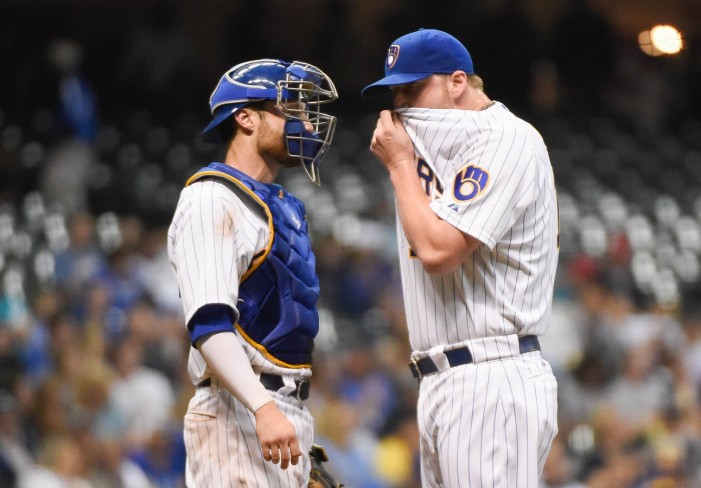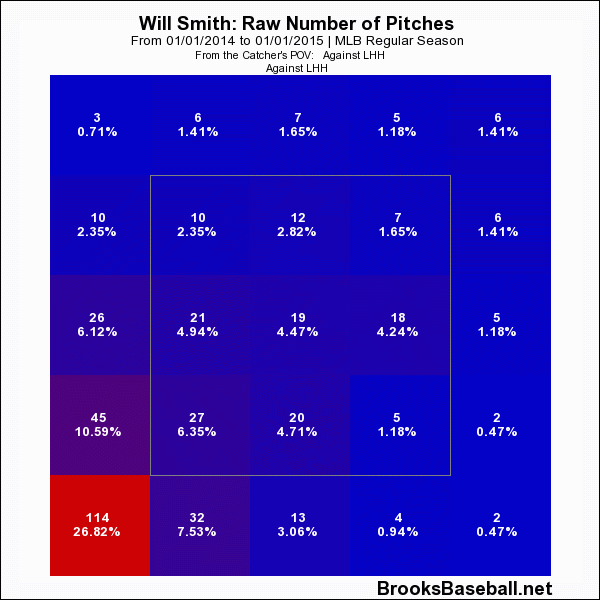In his second full season with the Brewers, Will Smith pitched very well. No one can complain about a 67 ERA- across 63.1 innings, especially when it comes with a 75 DRA- and 68 cFIP. Riding an incredible slider, Smith learned how to retire right-handed batters, who tallied an uninspiring .193/.264/.281 line and .208 TAv off him. That allowed him to put together a 2015 to remember, one that he stands a good chance of repeating in 2016. Two years after the Nori Aoki trade, it’s quite clear that Milwaukee came out ahead of Kansas City.
With that said, Smith’s 2015 had a pretty sizable blemish. Righties didn’t give him much trouble, but lefties did — they knocked him around for a .257/.330/.455 triple-slash, translating to a .285 TAv. This didn’t go unnoticed: The Milwaukee Journal-Sentinal wrote about it in May, and the Brewers’ official site covered it in September. Given that Smith had dominated southpaws in 2014, this seems like a legitimate worry, something that could undermine his performance in the years to come.
Here’s the thing: Smith didn’t really struggle against left-handed hitters this season. Rather, he fell victim to some misfortune, which inflated his numbers over a small sample. In the long term, when Smith has accumulated enough batters faced for us to place more faith in his numbers, we’ll see his 2015 lefty results as an aberration, not as indicators of truly poor performance.
We’ll start with the basics. Of the 116 southpaws who came to the plate against Smith this year, 12 earned a base on balls. That gave them a 10.3 percent walk rate, a mark that doesn’t bode well. But 43 of them went down on strikes, and a 37.1 percent strikeout rate will negate virtually any level of free passes. Those figures didn’t diverge too much from the respective 32.4 percent and 8.1 percent he notched against righties. As I explained in the article cited above, Smith used his slider more indiscriminately this year, which gave him a lot more whiffs (and fewer strikes) against everyone.
The difference between lefties and righties came with regards to contact. Whereas the latter mustered a meager 0.7 percent home run rate and .291 BABIP, the former smacked their way to a 3.4 percent home run rate and .386 BABIP. Balls in play hurt Smith this year, and as we all know by now, those can fluctuate wildly in a small sample without reflecting any variation in underlying talent.
Let’s look at the four home runs that lefties hit off Smith. There was:
- This four-bagger to Adrian Gonzalez, which required him to reach about as far as humanly possible:
- This long ball to Anthony Rizzo, which came on a pitch down and somewhat away:
- This shot to Michael Brantley, which arrived down the middle and slightly in:
- And this round-tripper to Jason Kipnis, which occurred on a pitch that should have jammed him:
Of these four pitches, only two truly count as mistakes. Gonzalez and Kipnis simply took spectacular swings, which we’d expect from hitters with respective 2015 TAvs of .302 and .290. Replace those two with singles, and Smith’s slugging percentage versus lefties plummets nearly a hundred points, to .356. In a sample as infinitesimal as this, a few slip-ups — or bad breaks — can have a tremendous impact.
Even more importantly, Smith didn’t throw these kinds of pitches often. When facing a batter of the same handedness, he almost always located down and away, to a slightly greater extent than he did last year:
As with his home-run issues, Smith’s BABIP troubles against lefties arose primarily when he placed the ball elsewhere. He didn’t take that route often, like last year, but hitters punished him on the rare occasions when he did.
Perhaps, since Smith stayed the same, lefties adjusted their approach against him and capitalized on his predictability. That could certainly be the case, especially when their 39.3 percent hard-hit rate enters the discussion. But this still looks far too fluky for my liking. These numbers transpired over 61 balls in play — that’s nothing. If a few more of those had found their way to a defender’s glove, none of this hubbub would have happened in the first place. (Plus, if they had adjusted, they probably wouldn’t have gone down on strikes so often.)
Smith’s 2014 campaign saw southpaws hit the ball out of the park in 1.9 percent of their chances, while accruing a .298 batting average on balls in play. Together with a heavy dose of strikeouts and a reasonable amount of walks, this gave them a .167/.245/.271 batting line and .210 TAv off him. The Smith who accomplished that doesn’t differ much from the Smith who came up short in 2015; if I had to guess which one will appear next year, I’d bet on the 2014 version.
In both the JS article and the Brewers.com article, the sources interviewed couldn’t find any real cause for Smith’s lefty hardships. As a matter of fact, Craig Counsell attributed the development to a small sample size in the former post, saying that “sometimes when we see numbers we have to step back and say, ‘What is this really telling us and how much do we trust it?’”. I wholeheartedly agree with his thinking here — the numbers don’t tell us what we might think they do.

